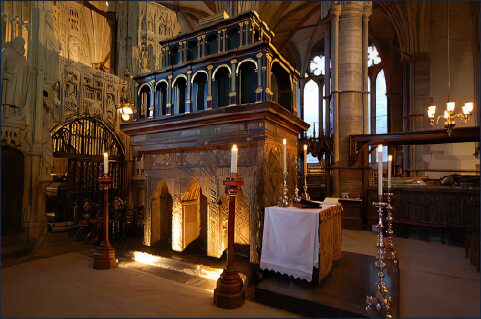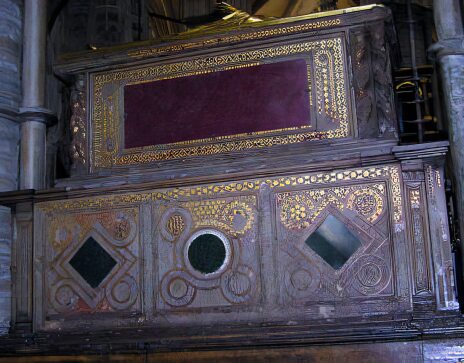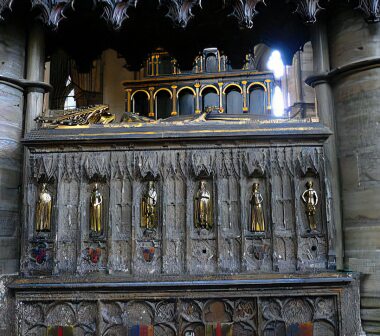Westminster Abbey
On the death of King Edward the Confessor in 1065, he was buried at the newly completed Westminster Abbey and his posthumous reputation came to be revered. His remains were not, however, allowed to rest in peace and were exhumed many times in the proceeding centuries.
The Shrine of St. Edward the Confessor
Henry I and his half-Saxon Queen, Matilda of Scotland, had her great uncle, the Confessor's tomb opened in 1098. The corpse was duly reported to be uncorrupted, at the time considered to be sure evidence of saintliness. Bishop Gundulf, who was present at the time, was said to have plucked a hair from Edward's long white beard, for which he received a severe reprimand from the Abbot of Westminster.
Edward's coffin was once again opened by Henry II, during this second exhumation, the King's burial robes were removed and the pilgrim's ring he was found to be wearing was appropriated by Henry II. Edward was canonized by Pope Alexander III in 1161.
When his fervent admirer, Henry III, rebuilt Westminster Abbey in the thirteenth century, the Confessor's body was translated to a magnificent shrine which became the centerpiece of the new building. Henry III himself, along with his brother, Richard, Earl of Cornwall and his two sons helped to carry the coffin to its splendid new resting place. The shrine, built by workmen from Italy, was originally composed of three parts, a stone base decorated with Cosmati work, a gold feretory containing Edward's coffin, which was flanked by statues on pillars of St. Edward and the Pilgrim, with a canopy above it which could be raised to reveal the feretory or lowered to cover it. The feretory must have been spectacular, it was decorated with the figures of six gold kings, set with precious stones. There are six niches, three on each side, which people could kneel in to pray to the saint.
Henry III presented the relic of a stone said to bear the marks of Christ's feet, from his Ascension, a relic of the girdle of the Virgin Mary and four silver basins for lamps. His son Edward I gave it the Crown of Llywelyn the Last and the spoils of his Scottish conquests. King Richard II donated a costly silver table enamelled with the story of the Confessor and the Pilgrim, while Caxton reported seeing an impression of King Arthur's seal set in beryl.
Tomb of Henry III
The Shrine is regarded as the centre of the Abbey and five kings and four queens lie buried in the Chapel, including Henry III, Edward I and his Queen Eleanor of Castile, Edward III, his consort Philippa of Hainault, their grandson Richard II with his queen Anne of Bohemia and King Henry V. Edward's Queen Edith of Wessex who died in 1075, is buried near her husband's Shrine.
St. Edward's shrine stands in its chapel behind the high altar, the chapel has a cosmetic floor of marble, semi-precious stone and glass similar to that in front of the High Altar, which has recently been restored. On the western side of the Chapel is a stone screen with fourteen scenes of events, real and legendary, in the life of the Confessor.
Tomb of Edward III and Phillipa of Hainault
The shrine was to become a popular place of pilgrimage throughout the middle ages, many of the sick came to pray at the shrine for a cure and the steps in the recesses of the shrine base are worn away by the knees of pilgrims. A cult of St Edward grew up, however, after the death of Henry III the cult witnessed a slow decline and St George eventually became recognised as the patron saint of England.
The Shrine of St. Edward was desecrated at the Dissolution of the Monasteries during the reign of King Henry VIII, the shrine itself was melted down and the jewel-encrusted offerings presented to Henry VIII, St. Edward's body was buried in an obscure spot in the Abbey. It was restored in the reign of his devoutly Catholic daughter, Mary I, the Purbeck base of the shrine was re-assembled, the queen donated jewels to replace those which had been removed and the saint's remains were returned to it.
The last disturbance of the King's rest occurred in 1685, where workmen were engaged in the removal of scaffolding used in the coronation of James II. A rafter fell, crashing into Edward's coffin. A crucifix and chain were discovered under his shoulder bones and were given to James II. During James' hasty flight from England in 1688 they were stolen by fishermen.
The site of the saint's original grave has remained a mystery since his body was moved twice before being laid to rest at the shrine. The original tomb, located during a recent archaeological study at the Abbey using the latest ground-penetrating radar, was located ten feet behind the modern-day altar, directly under the area of the shrine
Westminster Abbey PreviousNext Charles I at Carisbrooke Castle
